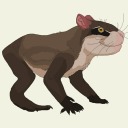Just some quick anatomy concepts since I’ve been getting plenty of questions about them!
I’ve been asked about whether ratbats were more like true bats or like pterosaurs anatomically, especially regarding the flexibility of the wing fingers, and I realized I’d never brought those up. Basically, the basal ratbat lineage that arose in the Late Rodentocene had similar anatomy to true bats, with flexible wing fingers and a sprawling gait on the ground, though their hind legs are not reversed like true bats and they cling to branches when “perched” with all four limbs (the large, early Rodentocene ratbats did hang upside-down to roost, so they can easily drop into flight, though I’m not all too certain whether that would require them to have reversed legs.)
Later forms, however, would adapt to soaring, developing more rigid pterosaur-esque wing fingers, especially the leading one of the two, and a more erect stance on the ground that made them significantly more competent on land, which facilitated some species to become flightless on islands without competition. However, even in the Temperocene the basal flexible-winged clade thrives as small fast-flying insectivores as they have much more agility and maneouverability midair when chasing evasive bugs.
Another FAQ was the leviahams’ flipper-propelled swimming style more akin to sea lions and pliosaurs as opposed to the fluke-powered style of whales and seals. Their ancestors the searets did have longer tails, but they were mostly used for steering and changing direction while the hind limbs did much of the propulsion. Basal leviahams that arose quickly in the Therocene would quickly grow big to occupy marine predator niches, but still kept land features like whiskers and claws after becoming fully-aquatic, now using all four limbs in alternating front-hind strokes, and here the tail becomes smaller to serve primarily as a rudder, and by the Late Therocene and Glaciocene the really big ones had lost these remnant features and resembled marine chelonians and pleisiosaurs in their mode of swimming.



